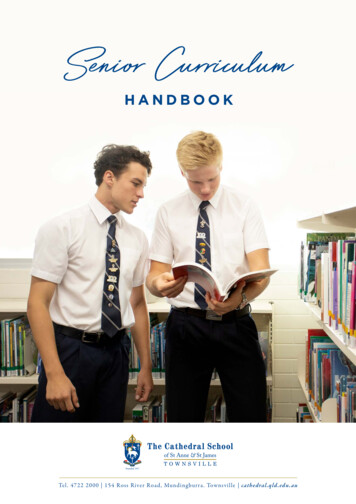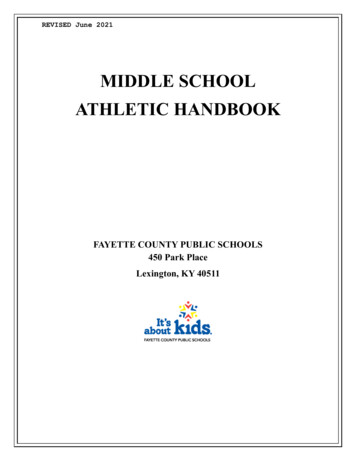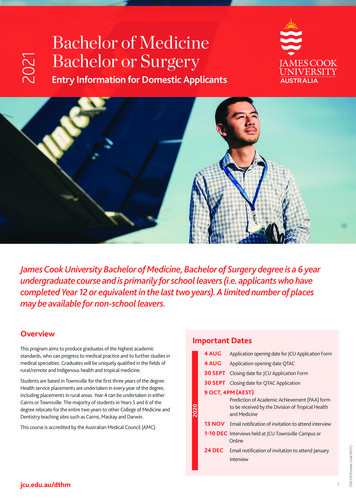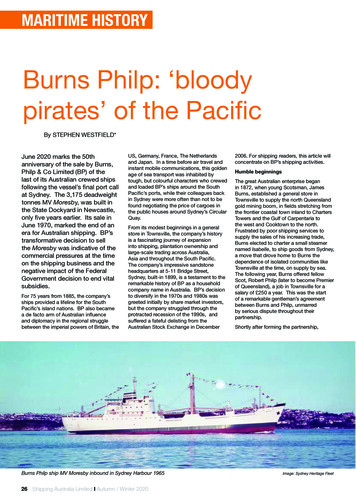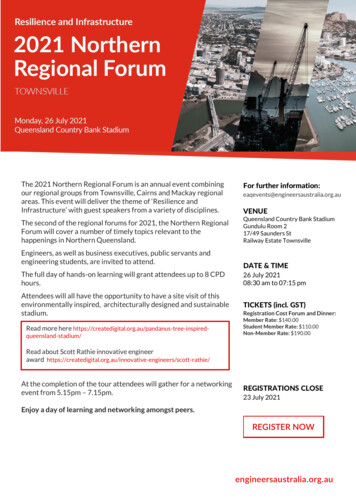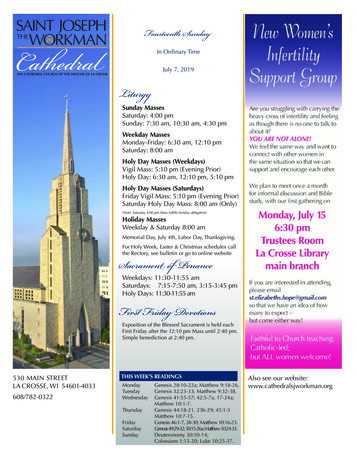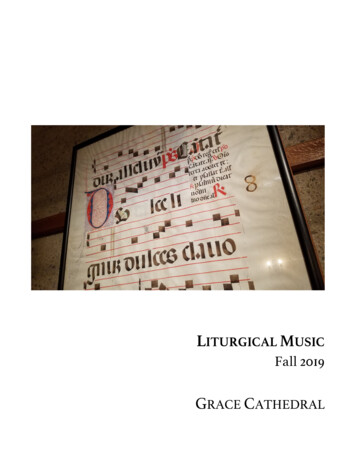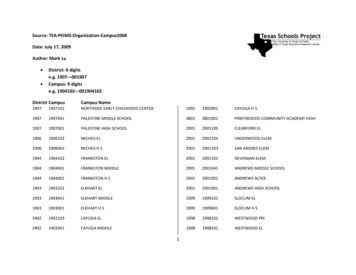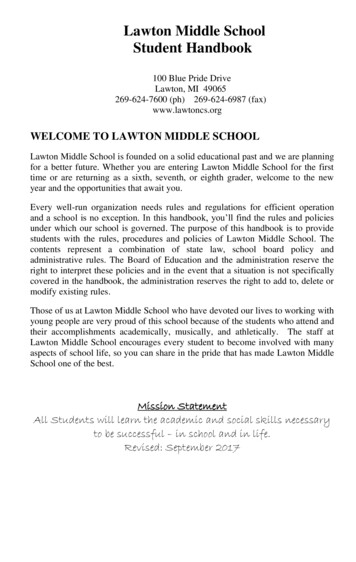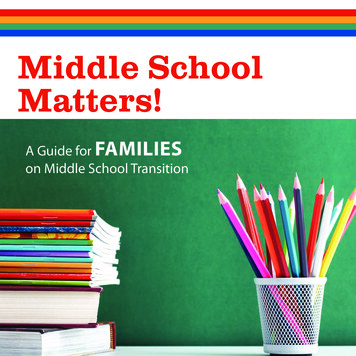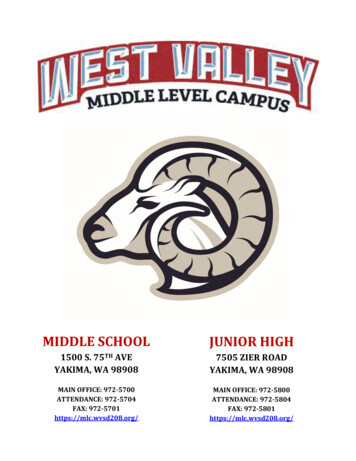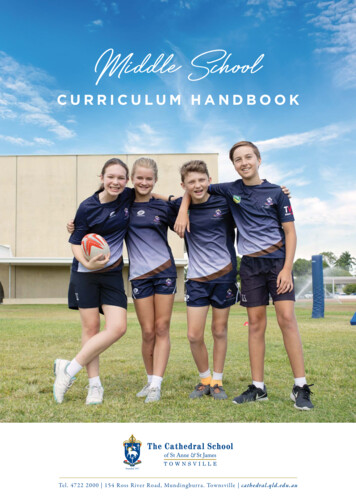
Transcription
Middle SchoolCURRICULUM HANDBOOKTel. 4722 2000 154 Ross River Road, Munding burra . Townsville cathedral.qld .edu.au
WelcomeWelcome to Middle Schooling at The Cathedral School. This CurriculumBooklet is a guide for students as they enter the middle years phase oflearning - Years 7, 8 and 9. This phase of learning is very much aboutdeveloping increased independence as students transition out of the JuniorSchool and begin to develop the skill sets they require to prepare themfor the demands of Senior Secondary Schooling in Years 10, 11 and 12.There are 7 Middle School values that were identified by the first MiddleSchool students in 2006. These values have become embedded andexpected within the Middle School. The 7 Values are Respect, Responsibility,Consideration, Trustworthiness, Friendship, Fairness and Endeavour. Thesevalues will set the foundation for students engaging and learning in theMiddle School whilst also preparing them for the Senior School and beyond.Year 7 is a foundational year where students maintain a core curriculumcovering the Australian Curriculum Key Learning Areas (KLAs) of:English, Mathematics, Science, Humanities (History and Geography),Technology, The Arts, Languages other than English (Japanese) andHealth and Physical Education. Students also study Christian Educationand Philosophical Inquiry as part of their school curriculum studies.In Year 8, Technology and The Arts become elective subjects and studentshave the opportunity to choose four semester long units to study coveringa selection of subjects within these two disciplines. These options include:Music, Visual Art, Drama, Digital Technology and STEM Enrichment.In Year 9 students also choose four semester long subjects to study;however, Japanese becomes an elective option, along with Economicsand Business. The time allocated for each of the electives increasesin place of the compulsory LOTE study that occurs in Year 8. Thisstructure remains the same when students enter Year 10.Mr Chris AndersonMs Karen BrennanHead of Middle SchoolAssistant Head of Middle School2 T HE CATHEDRAL SC HOOL
TABLE OF CONTENTSMiddle School Values5Pastoral aphy11Technology12Japanese14The Arts - Drama16The Arts - Music17Visual Arts18Life Skills & PE19Christian Education20Philosophical Inquiry20Extension & Enrichment21Extra Tuition22Outdoor Education23Learning Support23Extracurricular Activities24Leadership Development25Notes26MI DD L E S C H O O L C U R R I C U LU M H A N DB O O K 3
4 T HE CATHEDRA L SC HOOL
MI DDLE SCHOOL VALUESPASTORAL CAREEmbedded into the Middle School areSignificant educational research has7 core values that capture the culture ofconfirmed that adolescent students needthe school and underpin how classroomsa challenging curriculum delivered in anoperate. These values are also outlinedenvironment that provides social andin the student diary as follows:emotional support. This is exactly whatRESPECTTreating others with respect - Being tolerant ofdifferences - Including everyone - Using goodmanners, not bad language - Being considerate ofothers’ feelings - Not threatening or hurting anyone- Promoting equity - Allowing others freedom Celebrating others’ achievements - Obeying rules.happens at The Cathedral School.Pastoral care is central to the philosophy andorganisation within the Middle School. Each studenthas the stability of a home class group (called a TutorGroup) with one of the key teachers of that classhaving a designated pastoral care role (the Tutor).Our tutors are energetic, empathetic and committedRESPONSIBILITYDoing what you are supposed to do - Beingaccountable for your actions - Always doing yourbest - Using self-control - Acting in accordancewith principles of moral and ethical conduct Standing up for the rights of others - Buildingrelationships with the local community.to providing the scaffolding needed to supportC O N S I D E R AT I O NCaring for yourself and others - Being kind Including everyone - Showing you care - Usinggood manners - Helping people in need - Forgivingothers - Accepting everyone as they are - Showingcompassion and empathy - Being a good ‘neighbour’.The 3-way partnership between student, family, andTRUSTWORTHINESSBeing honest - Being sincere - Seeking the truth - Notdeceiving, cheating or stealing - Doing what you sayyou’ll do - Being loyal - Having the courage to do the‘right’ thing - Engaging in open communication.works together with the tutors to make the year aFRIENDSHIPAccepting diversity - Offering the hand of friendship Cooperating with others - Not arguing for the sake ofit - Listening to others - Offering thoughtful advice.for the particular year level. The current year levelFA I R N E S SPromoting equity and giving everybody a go Ensuring everyone is treated fairly - Playing bythe rules - Taking turns and sharing - Not takingadvantage of others - Not casting blame carelessly.Year 8 The Year of Possibility - Strive, Respect, GrowE N D E AVO U RSeeking to accomplish something worthyand admirable - Always giving your best inall you do - Pursuing excellence - Living tolearn - Encouraging each other to succeed.students in all facets of their school life.The tutor is the ‘constant’ in the students’ year, withdaily Tutor Group meetings and significant subjecttime spent together. The tutor is also the first pointof contact for parents, and strong relationships aredeveloped with students and their parents/guardians.school is essential in supporting students throughtheir adolescent years.Each year level in the Middle School also has aYear Level Dean who oversees the pastoral care/behaviour management of the year group, andsuccessful and productive one for the cohort. Eachyear level adopts a theme that is used as a frameworkfor their operation as a cohort. This theme is oftenaccompanied by a catchphrase that provides a focusthemes are as follows:Year 7 The Year of Opportunity - Habits andGreat OpportunitiesYear 9 The Year of Responsibility - One VoiceMiddle School tutors and the Middle SchoolLeadership Team work together to monitor, assist andencourage all students.MI DD L E S C H O O L C U R R I C U LU M H A N DB O O K 5
ENGLISHThe Middle School English program is based around three interrelated strandsthat support students’ growing understanding and use of English:LANGUAGELITERACYStudents develop their knowledge about theEnglish language and how it works to communicateeffectively through coherent, well-structuredsentences and texts.Students apply their English skills andknowledge to listen to, view, read, speak, writeand create a growing repertoire of texts.They learn how language enables people to interacteffectively, to build and maintain relationships, and toexpress and exchange knowledge, attitudes, feelingsand opinions.They learn about patterns of English usageand grammar at the level of the word, thesentence and the extended text, and they learnthe connections between these levels.They learn about spelling and thepurposes of punctuation.L I T E R AT U R EStudents learn to interpret, appreciate, evaluate,and create literary texts such as narrative,poetry, prose, plays, film, and multimodal textsin spoken, print, and digital/online contexts.Texts are chosen because they are judged tohold meaning and significance for young people;they represent interesting and effective featuresof form and style; and they are recognisedas having enduring or artistic value.Texts are drawn from a range of cultural contexts,international and Australian literature, includingoral narrative traditions as well as contemporaryAboriginal and Torres Strait Island literature, textsfrom the Asia region, and texts of students’ choice.6 T HE CATHEDRAL SC HOOLThey learn to comprehend, interpret and createspoken, written and multimodal texts, anduse the English language accurately, fluently,critically, creatively and confidently.They learn to manipulate and adapt languageto meet the demands of more general or morespecialised purposes, audiences and contexts.They learn about the different waysin which knowledge and opinion arerepresented and developed in texts.ASSESSMENTOver the three years of the course, the assessmentwill reflect the organising principles of continuity,increasing complexity of challenge, range,increasing independence and accommodationof cultural, social and individual differences.Assessment tasks comprise of a combinationof written, spoken and multimodal genres.
MI DD L E S C H O O L C U R R I C U LU M H AND B O O K 7
MATHEMATICSMathematics in the Middle School continues to build on the foundations developedin the Junior School Program and feeds into the Senior School Program. A key focusof Middle School Mathematics is numeracy, where this refers to the application anduse of mathematical skills, knowledge and procedures in real-world applications.TOPICS OF STUDYASSESSMENTMathematics in the Middle School focuseson three key strands namely:Mathematics assessment in all Middle School years willalign with the assessment that students will encounterin the Senior School Mathematics subjects.Number and AlgebraMeasurement and GeometryProbability and StatisticsThese topics are developmental in nature, eachcontaining many sub-topics. Previously introducedconcepts are reviewed and then expandedon, as the curriculum spirals over time.TECHNOLOGY USEUse of calculators is required in all Middle SchoolMaths classes. This does not mean, however,that there is no place for mental arithmeticor showing mathematical reasoning.Other applications used include MicrosoftExcel and web based graphical-modellingprograms such as Graphmatica.8 T HE CATHEDRAL SC HOOLIn each year, assessment will usually include foursupervised exams, and one extended Modelling andProblem Solving Task. Some exams will have a noncalculator component.ASSESSMENT CRITERIAQuestions in Maths are classified as either:Simple Familiar (60%)Complex Familiar (20%)Complex Unfamiliar (20%)Modelling and Problem Solving Tasks will requirestudents to formulate, solve, verify and thencommunicate their response in relation to aninvestigative type scenario. E.g. Is it feasible inTownsville to collect and store rainwater from the wetseason to use to irrigate a home garden throughoutthe dry season?
MI DD L E S C H O O L C U R R I C U LU M H A N DB O O K 9
SCIENCEScience is a way of answering questionsYear 7 Course Outlineabout the natural world. The body ofWhy do icebergs float?(Chemical Sciences)scientific knowledge and understandingis as important as the knowledge itself.Students will become familiar with the differencesbetween pure substances and mixtures. They learnabout mixtures, solutions and separating solubleand insoluble substances. Students will also engagein a range of laboratory-based experiments andinvestigative learning experiences to build theirlaboratory skills and learn to work with scientific data.Students will develop skills in separating mixturesby applying physical separation techniques.CONTENT STRANDSThat’s my habitat!(Biological Sciences)has been built upon questions which havederived from observations and the gatheringof evidence. This body of knowledge andunderstanding is continually changing, andin recent years it has been rapidly increasing.The process of building scientific knowledgeThe Middle School Science curriculum isorganised around the three interrelated strandsof the Australian Curriculum for Science. Eachof these strands is of equal importance:Science Understanding - incorporates knowledge andunderstanding of the four sub-strands of Biological,Chemical, Physical and Earth and Space Sciences.Science Inquiry Skills - incorporates skills ofinvestigation, analysis, evaluation and communication.Science as a Human Endeavour - incorporatesthe nature and development of scienceand the use and influence of science.The curriculum focus for the Middle Schoolis to provide students with understanding,knowledge and skills through which they candevelop a scientific view of the world.THINKING SCIENCEThe Thinking Science program is an evidencebased program designed to accelerate learners’cognitive function and foster the development ofcritical and creative thinkers. Students are given theopportunity to tackle problems collectively to reachconclusions and reflect on the thinking processesused. ‘Thinking skills’ is one of the seven generalcapabilities included in the content descriptors andachievement standards of the Australian Curriculum.Students gain an appreciation for the phenomenaof science, a practical understanding of concreteconcepts and improved confidence and participationdue to its carefully planned delivery. The ThinkingScience program runs parallel to, but does not replace,other science lessons which cover the AustralianCurriculum. The thinking skills students gain, leadto improved performance in thinking across allsubjects, long after the program has been taught.ASSESSMENTIn Science, assessment items include practicaltasks, scientific reports and understandingof content and process tests.1 0 THE CATHEDRA L SC HOOLStudents explore the hierarchy and classificationof living things. They will develop and understandthe concept of food webs as a means of depictingthe feeding relationships between organisms andexplore the biotic and abiotic factors necessaryfor the survival of living things. Students willpredict the effect of human and environmentalchanges on interactions between organisms.Pushing and Pulling(Physical Sciences)Students investigate forces, and how they canchange the motion of an object. They considerthe impact of friction on moving objects andappreciate the role of forces in their everyday lives.Dark Side of the Moon(Earth and Space Sciences)Students explore the relative movements of the Earth,sun and moon and how natural phenomena suchas solar and lunar eclipses and phases of the moonoccur. They recognise that some of Earth’s resourcesare renewable, including water that cycles throughthe environment, but others are non-renewable.
Year 8 Course OutlineYear 9 Course OutlineAct and think as a scientistPatterns of chemistry(Chemical Sciences)Students engage in a range of laboratorybased experiments and investigative learningexperiences to work with scientific data.Transform your energy(Physical Sciences)Students understand that energy appears in differentforms, including movement (kinetic energy), heatand potential energy. They will investigate howenergy is generated and transformed in order tomeet society’s energy requirements while taking intoaccount sustainability and ethical considerations.Cells to systems(Biological Sciences)Students examine a variety of cells using a lightmicroscope and learn to recognise their specialisedstructures and functions. They will explore howsome organisms reproduce, starting at a cellularlevel, and compare this to multicellular organisms.What’s the matter?(Chemical Sciences)Students examine how chemical reactions areused to describe the patterns of change observedin systems in which matter transforms.Changing Earth(Earth and Space Sciences)Students investigate the development ofthe theory of plate tectonics and how itexplains global patterns of geological activityand continental movement. They relate theoccurrence of earthquakes and volcanic activityto constructive and deconstructive boundaries.Life in the balance(Biological Sciences)Students explore the overarching ideas ofstability and change through the investigationof body systems and ecosystems. They focus onhow multicellular organisms rely on coordinatedand interdependent internal systems torespond to changes to their environment.Students engage in a range of laboratory-basedexperiments and investigative learning experiencesto explore changes in matter at a particle level anddistinguish between chemical and physical changes.They will appreciate that scientific knowledgechanges as new evidence becomes available.Waves and particles(Physical Sciences)Rockin’ all over the world(Earth and Space Sciences)Yr 8 & 9 STEM Enrichment ProgramStudents investigate the dynamic natureof the rock cycle. They appreciate whereand why rocks have been used in buildingsand monuments in the local area.Students examine aspects of the chemical andphysical sciences through atomic and wave models.Their understanding of these models is developedand reinforced through practical investigations.This subject is designed for students who have aparticular interest in Mathematics and Science. Itis an opportunity for students to learn conceptsthat go beyond that of what is covered in theAustralian Curriculum to extend and enrich thescope of learning in both Mathematics and Science.Subject material is contextualised and targetedto focus on both current issues in the ScienceResearch Community and student interest.There is a particular emphasis on critical thinkingand problem-solving in complex scenarios.ASSESSMENTSupervised Examination and Extended Research Task.M I DD L E S C H O O L C U R R I C U LU M H A N DB O O K 1 1
HUMANITIESThe subject Humanities is based on the Australian Curriculum for Geography and Historywith each studied for one semester in Years 7, 8 and 9. The Middle School Humanitiescourse is purposely designed to provide students with a background in each of thesedisciplines which may be selected as separate subjects in the Senior School.Year 7The Ancient World(C . 60,000BC - C. 6 5 0 A D)The Year 7 curriculum provides a study of history fromthe time of the earliest human communities to theend of the ancient period, approximately 60 000 BC c.650 AD. It was a period defined by the developmentof cultural practices and organised societies. Thestudy of the ancient world includes the discoveries(the remains of the past and what we know) andthe mysteries (what we do not know) about thisperiod of history, in a range of societies includingAustralia, Egypt, Greece, Rome, China and India.Year 8The Ancient to theModern WorldHISTORYThe Middle School History curriculum focuses upondeveloping historical knowledge and understandingthrough the process of inquiry, research skilldevelopment and critical analysis of historical sources.The curriculum takes a world history approachwithin which the history of Australia is taught incontext. It does this in order to equip students forthe challenges of the world in which they live.ASSESSMENTIn the Middle School, all History is assessedvia the use of a variety of techniques suchas presentations, reports, essays, shortresponse and response to stimuli tests.(C . 650 - 1750)The Year 8 curriculum provides study of historyfrom the end of the ancient period to the beginningof the modern period, c.650 AD - 1750. This waswhen major civilisations around the world cameinto contact with each other. Social, economic,religious and political beliefs were often challengedand significantly changed. It was the periodwhen the modern world began to take shape.Year 9The Making of theModern World and Australia(1 750-1918)The Year 9 curriculum provides a study of thehistory of the making of the modern world from1750 to 1918. It was a period of industrialisation andrapid change in the ways people lived, worked andthought. It was an era of nationalism and imperialism,and the colonisation of Australia was part of theexpansion of European power. The period culminatedin World War I 1914-1918, the ‘war to end all wars’.YEAR 9ECONOMICS& BUSINESS(ELECTIVE)The subject Economics andBusiness is an elective unit offeredfor one semester in Year 9. Thecurriculum gives students theopportunity to develop theirunderstanding of economics andbusiness concepts by exploringthe ways markets work withinAustralia and globally. Students willconsider the interdependence ofparticipants in these economies,including the implications ofdecisions made by individuals,businesses and governments.ASSESSMENTIn the Middle School, Economics andBusiness is assessed via a researchassignment and a supervised test.1 2 THE CATHEDRAL SC HOOL
GEOGRAPHYThe Middle School Geography curriculum focuses on developing geographicalunderstanding through studies of the interactions between people and the environment,and the spatial distribution of human activities. Geography engages students ingeographical thinking that relates to their own lives and experiences. They apply inquiryapproaches to extend their previous knowledge, and learn new skills and approachesto problem solving and decision making. The Geography curriculum explores the mainfeatures of the biophysical environments of local places, Australia and the world.Year 7GeographyYear 9Water in the World focuses on water as an exampleof a renewable environmental resource. This unitexamines the many uses of water, the ways itis perceived and valued, its different forms as aresource, the ways it connects places as it movesthrough the environment, its varying availabilityin time and across space, and its scarcity.Biomes and Food Security focuses oninvestigating the role of the biotic environmentin food and fibre production. This unit examinesthe biomes of the world, their alteration andsignificance as a source of food and fibre, andthe environmental challenges and constraintson expanding food production in the future.Place and Liveability focuses on the concept ofplace through an investigation of liveability. This unitexamines factors that influence liveability and how itis perceived, the idea that places provide us with theservices and facilities needed to support and enhanceour lives, and that spaces are planned and managedby people. It develops students’ ability to evaluatethe liveability of their own place and to investigatewhether it can be improved through planning.Geographies of Interconnections focuseson investigating how people, through theirchoices and actions, are connected to placesthroughout the world in a wide variety of ways,and how these connections help to make andchange places and their environments.Year 8GeographyGeographyASSESSMENTIn the Middle School, Geography is assessedusing a variety of techniques including fieldreports, practical tasks and supervised tests.Landforms and Landscapes examines the processesthat shape individual landforms, the values andmeanings placed on landforms and landscapesby diverse cultures, hazards associated withlandscapes, and management of landscapes.Changing Nations investigates the changinghuman geography of countries, as revealed byshifts in population distribution. The unit exploresthe process of urbanisation and investigates thereasons for the high level of urban concentrationin Australia as well as issues related to themanagement and future of Australia’s urban areas.MI DD L E S C H O O L C U R R I C U LU M H A N DB O O K 1 3
TECHNOLOGYThroughout the Middle School years, students are introduced to a range of technologies,giving them an opportunity to learn new skills and make decisions about future subjectchoices based on their interest and aptitude in the various areas. Technology is brokendown into two sub-strands, Digital and Design Technologies. Within both of thesestrands, students go through the design process: Investigation, Ideation, Production,and Evaluation. Technology is a core subject that all students do in Year 7, and thenin Years 8 and 9, various technology strands are offered as semester electives.1 4 T H E CATHEDRA L SC HOOL
Year 7TechnologyYear 8 & 9Product Design & TechnologyStudents spend one semester focusing on the DesignTechnology strand where they engage in designprojects relating to the selection and justification ofmaterials used and various engineering principles.In the remaining semester, students focus on theDigital Technology strand where they learn aboutnetworks, data storage and secure transmission.Students also engage in projects where they designdigital solutions to identified problems. Studentswill also reflect on their learning and evaluatethe suitability of their own and others’ productsand processes and recommend improvements.( E L E C TI V E )ASSESSMENTProduct Design and Technology is apractical subject centered on design andproblem-solving. The subject aims to:1.Develop skills related to the designand construction of projects using avariety of materials such as timber andplastics to develop competency in usingspecialised tools and machinery.2.Analyse and evaluate designs (both theirown and others) to develop the capacityto make wise consumer decisions.3.Develop problem-solving skills, responsibleattitudes, independence, and creativity skills.Folios of work (demonstrating the design process).Year 8 & 9Food & Textiles Technology(E L ECTIVE)The Food and Textiles Technology electiveconsists of two units: Terrific Textiles and Foodand Nutrition, each 8 - 9 weeks in duration.Terrific TextilesThe textile unit concentrates on safety, textilestudies of natural fibers, and basic and advancedsewing skills. Students design and make twoarticles, such as a simple bag and pair of shortsin Year 8 and a foundation pieced patchworkarticle and an embellished reversible shoppingbag in Year 9. These projects give the studentsplenty of scope to demonstrate their artisticflair, sewing, and management skills.ASSESSMENTAssessment for the unit includes a writtenexamination, process journal and practical work.Food & NutritionThe nutrition unit concentrates on planning, makingand evaluating healthy food choices. Studentscomplete a weekly practical foods workshop whichconcentrates on hygienic and safe food preparation.ASSESSMENTAssessment includes a safety poster, a writtenexamination, process journal and healthy brunchpractical cookery exam.COURSE OUTLINEConstruction of one major design project usingwood, wood products and a second materiale.g. plastic/glass “Design Brief” researchassignments. Students research a design problemand on the basis of their research come up withpractical solutions to the problem. The bestsolution is then selected and constructed.The design project will centre on the use ofspecialised machines. Students are encouragedto use their design skills to solve design problemsin their own creative way. This part of the courseis great for students who have special interestsor ability in specialised areas of technology.ASSESSMENTDesign Folios demonstrating the design,construction and evaluation phases.Years 8 & 9Graphic Design Technology( E L E C TI V E )This subject aims to introduce studentsto graphical communication through avariety of areas. Students will learn: Basic Sketching, Orthographic Projection, PlaneGeometry, Perspective, Solid Modeling, Diagrams,and Charts, Rendering, and Pictorial Drawing.At the end of the one semester, course studentswill have an understanding of Two and ThreeDimensional Drafting using AutoCAD software. Thecourse is divided into 50% computer drafting and50% manual drafting. The Year 9 Graphics coursehas been set out to cater for all individuals.ASSESSMENTDesign Folios, Supervised Assessments.M I DD L E S C H O O L C U R R I C U LU M H A N DB O O K 1 5
J A PA N E S ETo become a global citizen, it is essentialLEARNING EXPERIENCESto learn a language other than one’s own.This course incorporates a wide variety of teachingand learning methodology to cater to a diverse rangeof learners. Digital technologies using a laptop arealso embedded into the course to assist in scriptand vocabulary acquisition, to access interactivecourse materials and create digital assignments.Students are given regular opportunities tocommunicate with native speakers through our schoolAssistant Language Teacher Program, and via emailcommunications and Skype lessons.This is not only to be able to communicatewith speakers of that language, but also todevelop an appreciation of other cultures.The Cathedral School recognises Australia’scross-curriculum priority of Asia and Australia’sengagement with Asia by offering a languageprogram that enables the development of richand engaging contexts for developing students’capabilities to engage with the language andculture of Japan. Students learn to communicateand interact in interculturally appropriate ways,and in doing so, gain an appreciation for the placeof Australia within the Asian region, including theinterconnections of languages and cultures, peoplesand communities, histories and economies.Japan has been a close strategic and economicpartner of Australia for more than 50 years, and thereis an ongoing exchange between the two countriesin the areas of education, trade, diplomacy andtourism. Being able to communicate in Japanese isa valuable asset in many careers such as; Business,Engineering, Technology, Law, Defence, Travel andTourism. We have built a strong relationship with ourSister Schools in Japan, Koueikan Middle School andSakuragaoka High School in Shunan City, YamaguchiPrefecture. Such relationships provide many excitingopportunities for our students to communicatewith Japanese students, by welcoming studentsto our school on a variety of exchange programsand visiting Japan on our biennial Japan Tour toexperience the language and culture first-hand.Years 7 & 8JapaneseASSESSMENTA portfolio style of assessment allows studentsto demonstrate proficiency in the language andunderstanding of Japanese culture by completing avariety of activities throughout each term.A variety of assessment techniques are used to allowstudents to demonstrate proficiency in the languageand understanding of Japanese culture, including bothexams and assignment tasks. Students create digitalpresentations, perform role plays, and analyse realisticwritten texts and audio materials.Year 9JapaneseJapanese is an elective subject in Year 9. Studentswill continue to develop language skills which willenable them to communicate effectively in everydaysituations. Students starting Year 9 Japanese musthave received a passing grade in Year 8 Japaneseand should be confident with reading and writing thehiragana and katakana scripts as a prerequisite for thiscour
Middle School CURRICULUM HANDBOOK . Welcome to Middle Schooling at The Cathedral School. This Curriculum . Humanities 10 Geography 11 Technology 12 Japanese 14 The Arts - Drama 16 The Arts - Music 17 Visual Arts 18 Life Skills & PE 19 Christian Education 20 Philosophical Inquiry 20
